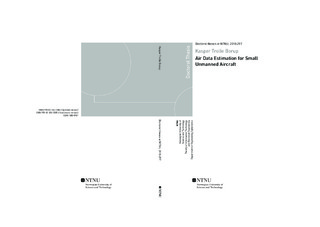| dc.description.abstract | The use of small fixed-wing unmanned aerial vehicles has shown an explosive growth in recent years and this thesis is motivated by the need for low-cost, accurate air data estimators for these aircraft. The air data contains information that is directly related to the performance of the unmanned aerial vehicle and is therefore valuable for operational control. However, the available market systems are often large, heavy, and expensive and alternatives without these limitations could potentially allow for new unmanned aircraft possibilities and applications.
This thesis briefly accounts for the influence of air data on fixed-wing unmanned aerial vehicle flight and continues to present three main contributions in air data estimation. The main results are:
A nonlinear model-based wind velocity observer for unmanned aerial vehicles: The observer exploits an aerodynamic model of the aircraft and an airspeed sensor together with a standard sensor suite consisting of a GNSS receiver, an inertial measurement unit, a Pitot-static probe, and a heading reference. The observer is shown to provide exponential stability and convergent estimates of both wind velocity and relative velocity from which estimates of the air data can be computed. The observer is verified through simulation using a realistic wind signal.
A machine learning approach for estimating air data for small fixedwing unmanned aerial vehicles using distributed pressure sensors: The air data estimation method consists of combining machine learning algorithms with an array of low-cost pressure sensors embedded in the surface of the unmanned aircraft. Two machine learning algorithms based on artificial neural networks and linear regression are implemented, tested, and assessed using data collected from wind tunnel experiments and a flight test and the results are compared to a benchmark flight test. Training the machine learning algorithms using wind tunnel data was found to introduce several potential error sources that need to be addressed in order to provide accurate estimation on the benchmark flight test, whereas training the algorithms using flight data provides lower estimation RMSE values. The performance of the neural network structures has been found to slightly outperform the linear regression algorithms in estimation accuracy. Lastly, results from using different sensor configurations and a pseudo Reynolds number are presented in an effort to evaluate the influence of sensor number and placement on the accuracy of the method.
Kalman filters for air data bias correction for a fixed-wing unmanned aerial vehicle: Two distinct Kalman filter approaches for correcting air data systems with low-frequency drift or a constant error bias for fixed-wing unmanned aerial vehicles are presented. The estimators use a GNSS receiver, an IMU, and a heading reference, combined with an air data system that is assumed to provide measurements with an unknown additive slowly time-varying bias. Neither estimator is dependent on the aircraft model. The estimators are, without the effect of noise, proven to have globally exponentially stable equilibrium points of the error dynamics if provided with persistence-of-excitation in the angular velocity and angular acceleration of the unmanned aircraft. The estimators are verified through simulation and using experimental flight data. The results from the experimental flight data are obtained using the machine learning approach described in the preceding paragraph. The flight results indicate that a certain amount of excitation is needed in order to have converging bias estimates during turbulent wind conditions. | nb_NO |
